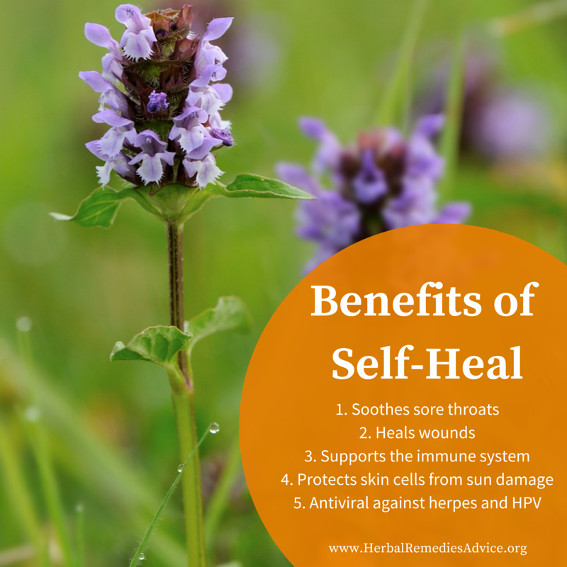Get weekly tips, recipes, and my Herbal Jumpstart e-course! Sign up for free today.
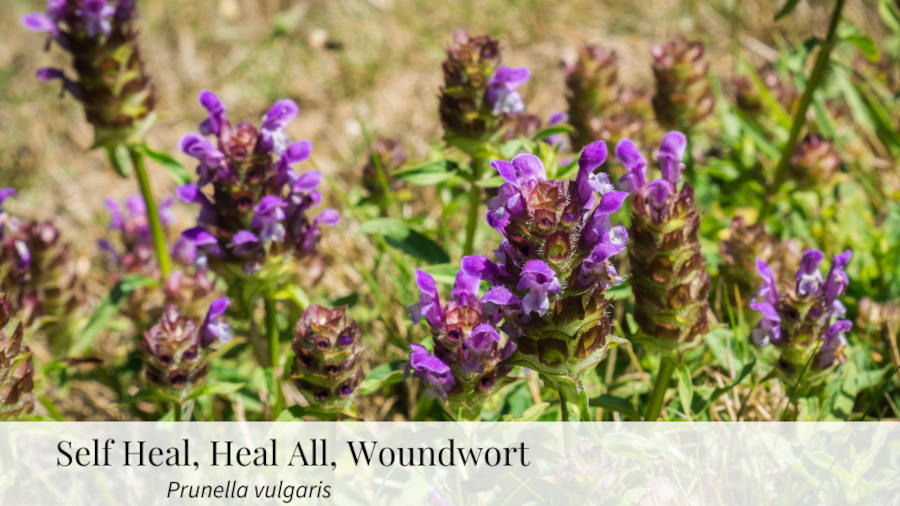
The Self Heal Herb
Share this! |
|
The health benefits of the self heal herb are so amazing! Sadly, self heal (Prunella vulgaris) is often overlooked or dismissed as an unwanted weed. But that’s a mistake! In this episode, I’m going to share some fascinating new research on self heal, especially in regards to skin health and cancer.
The versatile self-heal plant is also a great herb to turn to for many everyday health complaints. For example, self heal can help to relieve:
► Minor scrapes, cuts, and burns
► Sore throats
► The itchy, weepy redness of conjunctivitis
► and much more…
I’ll also share two favorite self heal recipes in this episode to protect your skin and keep you cool.
You don’t want to miss making friends with this lovely and gifted little herb!
After reading, you’ll know:
► How self heal’s energetics inform its medicinal uses (and where to learn more about herbal energetics!)
► How to identify self heal
► How to make a delicious, demulcent, super-refreshing self heal tea
► How to make a deeply soothing and nourishing self heal skin serum (your skin will thank you)
-- TIMESTAMPS --
00:00 - Introduction to the self heal herb (Prunella vulgaris)
02:57 - Self heal energetics
05:31 - Self heal can heal wounds and protect your skin
06:57 - Self heal cools summer heat and soothes your eyes
07:36 - Self heal kills viruses and modulates the immune system
08:43 - Self heal helps soothe sore throats and upper respiratory infections
10:30 - Self heal and thyroid health
11:00 - Self heal addresses cancer
12:28 - How to identify self heal
13:10 - Harvesting cautions
13:28 - Self heal recipes
18:11 - Self Heal Fun Fact
Download Your Recipe Cards
l
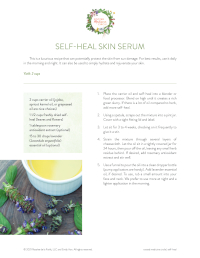
Transcript of the Self Heal Herb Video
Western herbalists love to love weeds. We hold up our golden dandelions as if they were a golden chalice and we praise the spread of the humble plantain.
But what about that small purple mint lurking in our lawns with the panacea-like name?
Self heal herb, heal-all, slough heal and woundwort are all common names for Prunella vulgaris. The genus name, Prunella, comes from the German word for quinsy, a severe sore throat caused by a tonsil abscess for which self-heal is said to be a cure. The species name vulgaris, meaning “common,” indicates the plant’s ubiquitous nature.
Self-heal is often overlooked in western herbalism. You won’t find it in a lot of herb books. But Chinese herbalists have long revered this powerful plant and in recent years researchers have been confirming self heal’s many benefits. There’s lots of fascinating new research studies, especially in regards to skin health and cancer.
Are you tuning into this episode on self heal because you already know and love this plant? I’d love to hear about your relationship to self heal in the comments at the bottom of this page. Your comments mean a lot to me! I love cultivating a community of kind-hearted plant-loving folks! Plus, it’s always interesting and insightful to hear the experiences of plant lovers out there. Your suggestion may also help others!
Okay, let’s dive in…
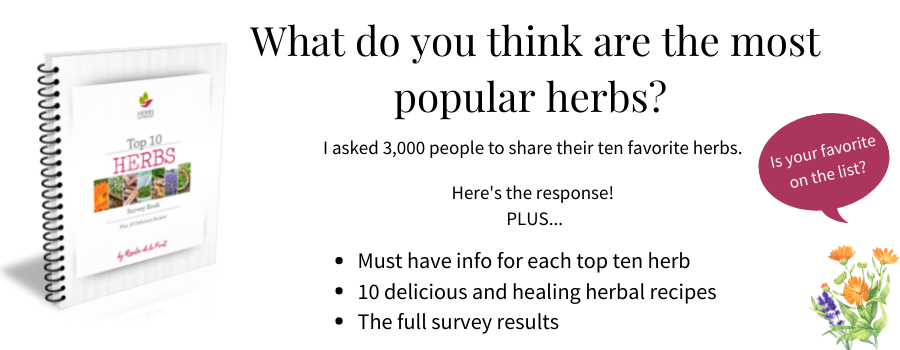
The Energetics of the Self Heal Herb
Strongly cooling in nature, self-heal is often used for signs of heat such as boils, hot rashes, sore throats, and sunstroke.
Self heal is so cooling that there are even warnings about it!
The Chinese Herbal Medicine Materia Medica book says that self-heal, due to its cool nature, could harm someone who already has weak digestion if it is taken in large amounts over time.
I realize you might be wondering what exactly I mean by self heal being a “cool” plant? Nope, this isn’t a commentary on its popularity; instead it’s even more basic.
You know how refreshing it is to eat a melon, a cucumber, or drink lemonade on a hot summer’s day? All of these foods are cooling in nature. They help your body deal with external heat.
The cooling nature of self heal is the same concept. Whether you are dealing with the external heat of the sun or internal heat such as a boil or rash.
Understanding whether a plant is cooling or warming is part of the study of herbal energetics.
Whether this is your first video with me or your 17th, you should know that I love herbal energetics and consider this an essential part of herbalism. Without herbal energetics it’s hard to really know how herbs work and how to get the best results when working with them.
Okay, sure, you could simply memorize many of self heal’s uses. However, you’d be missing out on understanding its special affinities. Instead, when you apply simple herbal energetics you will have a deeper understanding of the health benefits of self heal.
If you’re new to the concepts of herbal energetics and understanding if a plant or a condition is hot or cold or damp or dry then I highly recommend my free Herbal Jumpstart Course.
This short video course takes you through the ins and outs of herbal energetics and by the time you finish you’ll have increased your herbal knowledge 10 fold.
This course is entirely free to everyone who joins my herbal newsletter community. In addition to getting the free Herbal Jumpstart Course you’ll also hear from me every Wednesday with my best herbal tips and recipes. You can sign up using the link below.
Tired of herbal overwhelm?
I got you!
I’ll send you clear, trusted tips and recipes—right to your inbox each week.
I look forward to welcoming you to our herbal community! Know that your information is safely hidden behind a patch of stinging nettle. I never sell your information and you can easily unsubscribe at any time.
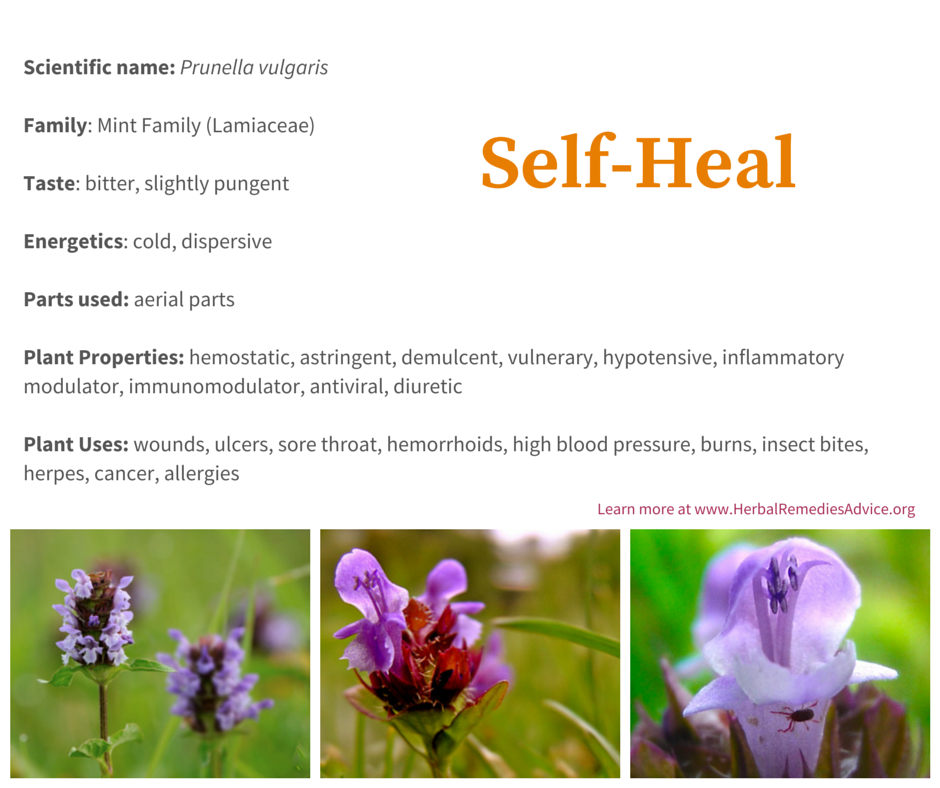
Okay, now that we know that self heal is cooling in nature, let’s see how that applies to the many ways we can work with this plant.
The Self Heal Herb Can Heal Wounds and Protect Your Skin
One of the health benefits of the self heal herb is how wonderfully it can heal wounds and protect the skin.
The herbal term for this is a vulnerary herb.
Self-heal can be used for a variety of minor injuries to the skin, including scrapes, cuts, and burns. It can be used to draw out infections such as boils and abscesses, and due to self heal’s cooling abilities it is especially indicated when there are signs of redness or warmth.
Severals studies have shown that self-heal has the ability to protect skin cells from UVA and UVB radiation.
In one in vitro study, researchers looked at self-heal as an herbal photo-protectant and concluded that it may offer defense against the sun when used in skin products. A 2018 in vitro study concluded that their findings regarding self heal and skin health, “indicate that treatment with [self heal extract] PVE has a potential protective effect against UVB-induced photoaging and photoinflammation.”
While we’re waiting for human clinical trials to confirm these findings, self heal-infused oils can be a nourishing addition to your skin-care regimen.
I’ll share how to make my favorite self heal skin serum which you can use to nourish your skin in just a bit.
The Self Heal Herb Cools Summer Heat and Soothes Your Eyes
Taken as a tea, self-heal can cool you body by dispersing internal heat. In Chinese medicine it is used to prevent and address summer heat and summer rashes caused by heatstroke.
You don’t have to wait until you have sunstroke though! I recommend drinking self heal teas on hot summer days. I’ll share my favorite simple infusion with you later in this episode.
Chinese medicine also recommends self-heal for signs of heat in the eyes, including redness, conjunctivitis, and tearing.
The Self Heal Herb Kills Viruses and Modulates the Immune System
Numerous studies have shown that self-heal has antiviral properties, especially against the herpes simplex virus. Researchers have shown that it inhibits the binding ability of the virus, making it most effective at preventing and stopping new outbreaks.
A 2021 study involving in vitro antiviral testing confirmed that self heal “substantially and stably inhibited acyclovir-resistant herpes strains” They went on to say that self heal worked better than acyclovir, which they were using as a positive control. Their final conclusion is that, “Overall, our findings support [self heal] as a potential drug resource for anti-herpes simple virus therapy.”
In a 2021 study researchers concluded that self heal extracts may be developed as a novel approach to the coronavirus infection based on their initial in vitro study. It will be interesting to see that research develop further.
The Self Heal Herb Helps Soothe Sore Throats and Upper Respiratory Infections
In addition to stopping viral outbreaks, self heal contains polysaccharides that are known to modulate the immune system which helps your body ward off infections. As I mentioned earlier self-heal has long been used to address sore throats and was historically used against quinsy, a sore throat caused by tonsil abscesses.
Self-heal is also a gentle and effective lymphatic, which can help address the swollen lymph glands that often accompany a sore throat. I like to include self heal in my sore throat spray recipes.
My favorite sore throat spray recipe is in our book, Wild Remedies. It’s a combination of three powerful herbs including Echinacea, Yarrow, and of course Self Heal.
If you already own Wild Remedies then you can find that recipe on 311.
When Emily Han and I wrote Wild Remedies we wrote waaaay too many plant monographs, they simply wouldn't all fit into one book! So we had to pull some of them, but what we decided to do was include three plants as bonus downloads when you buy the book.
Those plants are Self Heal, Calendula and Rose. If you own Wild Remedies but haven’t gotten your bonus downloads then find the simple instructions to do so at the end of that book.
If you haven’t yet bought Wild Remedies then what are you waiting for?
This book is perfect for you if you love trustworthy information about plants that grow around you plus lots of unique recipes for medicine and for food. You can find Wild Remedies wherever books are sold - please consider asking your local bookstore to order it for you.
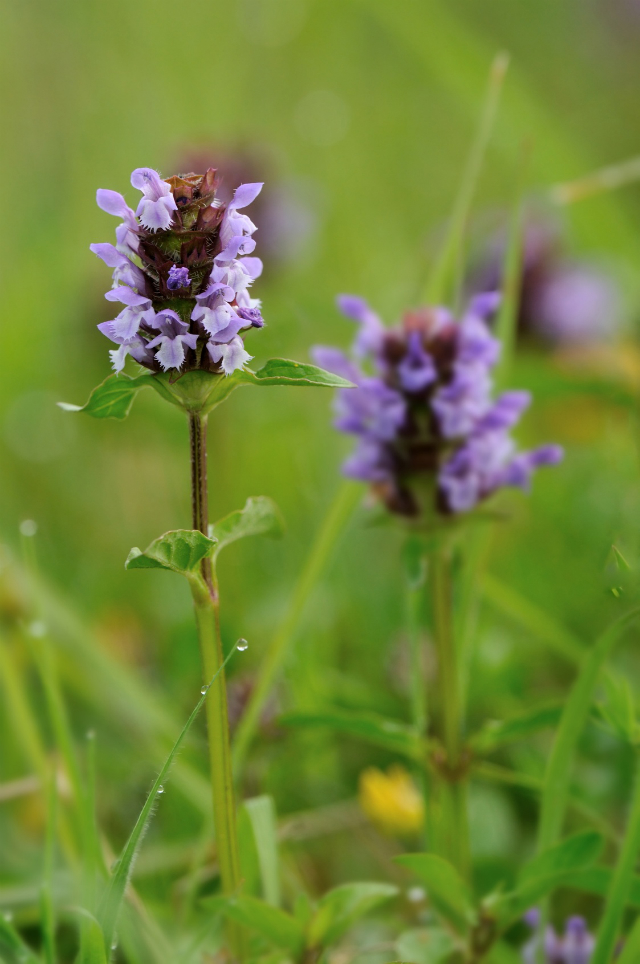
s
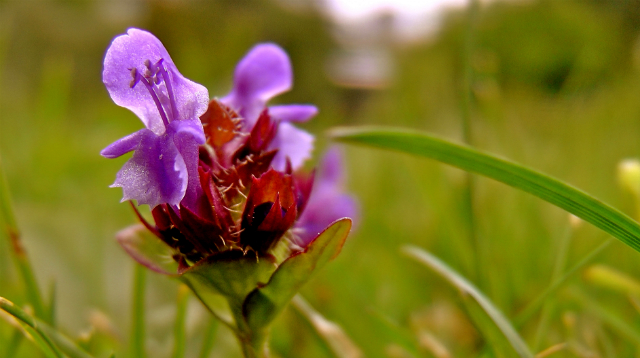
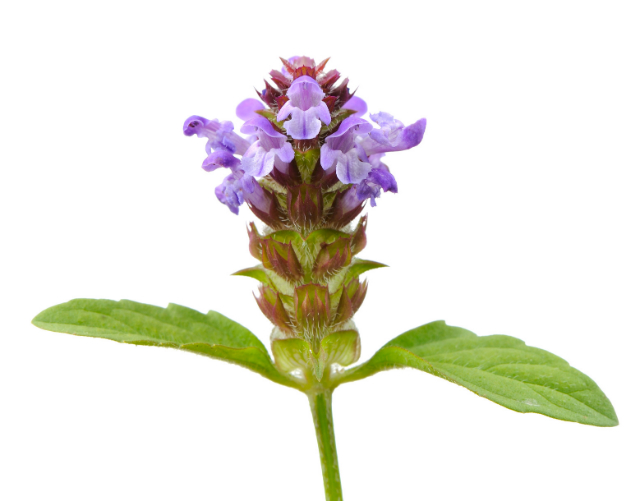
The Self Heal Herb and Thyroid Health
Chinese herbalists have long worked with self heal to improve thyroid health. In recent years there have been many studies looking at self heal’s effect on the thyroid.
There are interesting studies showing self heal’s ability to reduce thyroid nodules, address hashimoto’s thyroiditis, and even to address thyroid cancer. These studies are promising and I look forward to clinical trials.
The Self Heal Herb Addresses Cancer
Many in-vitro studies using self-heal extracts on lung, liver, and lymphoma cancer cells have shown promising results.
Self-heal has also been shown to reduce excess estrogen, and researchers hypothesize that it may have potential to address estrogen-dependent cancers.
In one human clinical trial involving patients with breast cancer, 424 people were split into two groups. One group received conventional treatment alongside a self-heal extract, and the other group received conventional treatment and a placebo. Those people taking self-heal had fewer side effects from the drugs and fewer deaths over a period of three years. The researchers concluded that self heal “may be a potential adjuvant medicine for breast cancer treatment.”
To date, there are very few human clinical trials involving self-heal and cancer, but I hope that the existing promising research will gain more interest for future clinical trials.
Let’s give a round of applause for self heal! I hope this episode has given you a deeper appreciation for the health benefits of the self heal herb! In other words: Don’t dismiss this powerful weed! Reach for self heal to cool you down, protect your skin, heal wounds, ward off viral infections, and even to address thyroid health.
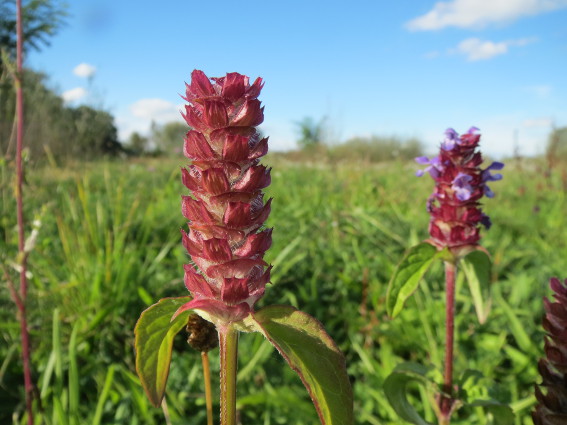
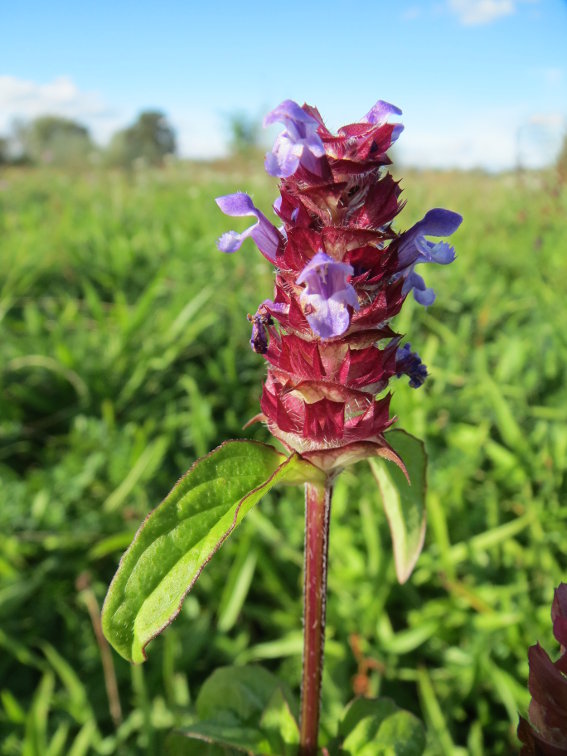
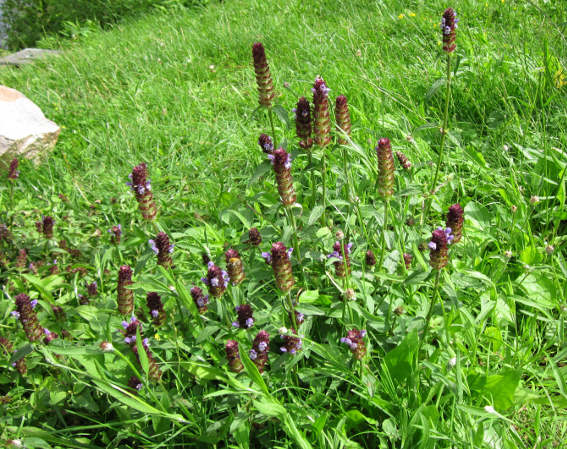
How to Identify the Self Heal Herb

The Self Heal Herb is a member of the mint family (Lamiaceae) and has the classic characteristics of this family:
1. The purple flowers have a lipped-shape appearance and grow on spikes.
2. The leaves are opposite each other on the stem.
3. The stems are square.
The flowers are purple with a lipped-shape appearance. Herbalists who discuss the Doctrine of Signatures might point out that the flowers look like a mouth and throat pointing towards its use for sore throats.
The plant grows close to the ground, up to one foot in height. It loves damp shady places and often grows in lawns. It will also grow in full sun. It grows all over the globe and readily spreads once established.
Cautions When Harvesting the Self Heal Herb
Self-heal does not have any strong look-alikes, although some people may misidentify bugleweed (Ajuga reptans), ground ivy (Glechoma hederacea), or purple dead nettle (Lamium purpureum), all of which are edible.
Self Heal Recipes
For this episode I have two favorite self-heal recipes to share with you. One is for protecting your skin and the other is for cooling you down in the hot summer heat.
Both of these recipes come from our live online herbal medicine making course, Rooted Medicine Circle. This course is a ten-month journey to strengthen your connection to the earth around you while learning how to make potent herbal medicines. We only enroll this popular course once a year, sometime in January, so if you’re interested, click here to get signed up on the waiting list.
Let’s start with the Self Heal Skin Serum.
This is a luxurious recipe that can potentially protect your skin from sun damage. For best results, use it daily in the morning and night. It can also be used to simply restore and rejuvenate your skin.
You’ll need the following ingredients:
- 2 cups carrier oil (jojoba, apricot kernel oil, or grapeseed oil are nice choices)
- 1 1/2 cups freshly dried self heal (leaves and flowers)
- 1 tablespoon rosemary antioxidant extract (optional)
- 15 to 30 drops lavender (Lavandula angustifolia) essential oil (optional)
To make this recipe…
1. Place the carrier oil and self-heal into a blender or food processor. Blend on high until it creates a rich green slurry and the container feels warm to the touch.
2. Using a spatula, scrape out the mixture into a pint jar. Cover with a tight-fitting lid and label.
3. Let sit for 3 to 4 weeks, checking on it frequently to give it a stir or shake.
4. Strain the mixture through several layers of cheesecloth. Let the oil sit in a tightly covered jar for 24 hours, then pour off the oil, leaving any small herb residue behind. If you’d like, add rosemary antioxidant extract and stir well.
5. Use a funnel to pour the oil into a clean dropper bottle. Add the lavender essential oil, if you’d like. To use, rub a small amount into your face and neck. I like to use more at night and a then a bit less in the morning.
Our next recipe is a super simple way to make a Cooling Tea
Are you feeling parched? Or overwhelmed by hot weather? This refreshing drink is the perfect way to cool down, and it can be enjoyed throughout the day. Self-heal, as I shared, is renowned for clearing heat from the body, mint helps to disperse heat through the skin, and mallow offers soothing relief to dry tissues. I like this drink chilled, like right out of the fridge, but it can also be enjoyed at room temperature.
To make this you’ll need the following ingredients…
- 1 large handful fresh self heal leaves and flowers, chopped
- 2 tablespoons fresh mint leaves, chopped
- 1 tablespoon fresh mallow leaves, chopped
- 4 cups water
To make this recipe…
1. Place all of the herbs in a quart jar.
2. Fill the jar with room temperature water. Cover the jar and let it sit in the refrigerator for a few hours or overnight.
3. Strain through a fine-mesh strainer, pressing down on the herbs to extract as much of the liquid as possible.
4. Drink throughout the day as needed, but drink it up within 24 hours.
Self Heal Fun Fact
The doctrine of signatures is the idea that plant parts can resemble the use or organ that they benefit. This idea has been around for thousands of years and, while I wouldn’t test out an herb using this method, it can be a good memory device. An example of the doctrine of signatures includes a walnut looking like a brain (walnuts are great for brain health, check out my interview with Nina Lawrin for more information).
So what does this have to do with self heal?
Well, the purple flowers of self heal are often said to resemble a neck and throat and the self heal herb is famous for relieving severe sore throats and for thyroid health.
Research Citations for the Self Heal Herb
Click to show/hide.

Rosalee is an herbalist and author of the bestselling book Alchemy of Herbs: Transform Everyday Ingredients Into Foods & Remedies That Healand co-author of the bestselling book Wild Remedies: How to Forage Healing Foods and Craft Your Own Herbal Medicine. She's a registered herbalist with the American Herbalist Guild and has taught thousands of students through her online courses. Read about how Rosalee went from having a terminal illness to being a bestselling author in her full story here.
